|
CUBA NOT RUSHING TO CHANGE
Marie Scott visits the Caribbean island where the natives are friendly and the pace is slow
“Go Now,” they urge. “Get to Cuba before it changes!” That’s the advice from travel pundits, who envisage a dramatic change to this Carribbean island once Fidel Castro is no longer on the scene and it emerges from its nostalgic time warp.
But don’t rush – the Cubans certainly don’t. And that’s the key to why this remaining bastion of Socialist ideals is unlikely to be transformed overnight.
The Cubans are laid-back, friendly and, although keen to enjoy some of the rewards they see their big neighbour enjoying, are generally proud of their island 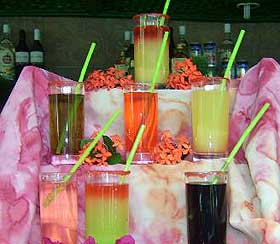 and the fruits of their Revolution, and show little inclination to join the rat race. Moreover, years of secure if low paid state employment have inculcated a languid attitude that will take some time and effort to alter. and the fruits of their Revolution, and show little inclination to join the rat race. Moreover, years of secure if low paid state employment have inculcated a languid attitude that will take some time and effort to alter.
With its vintage American cars, its crumbling colonial buildings, and profusion of cafes and bars, Havana’s a colourful, relaxed city on the cusp of change – but in ‘the Cuban way’, as they are fond of saying.
Time hasn’t exactly stood still but it has a different meaning here, where all appointments are negotiable, all services subject to possible delays, all activity conducted in ‘the Cuban way’.
That is undoubtedly part of its charm, and arriving in temperatures in the high 80s F from a UK still wrapped in Winter when it should have been Spring, it was easy to slip into similarly relaxed mode and call for another mojita.
Hit by the warmth of temperature and 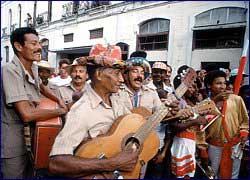 people at Havana airport, the journey into town shows a land blessedly free from plastic bags, on impressive roads with immaculately well tended borders. But entering the Old Town, amazing ruins line the way, once grand palladian-style buildings, covered in creepers, some just shells, leading to other rows of crumbling colonial buildings, many empty but others crammed with residents. people at Havana airport, the journey into town shows a land blessedly free from plastic bags, on impressive roads with immaculately well tended borders. But entering the Old Town, amazing ruins line the way, once grand palladian-style buildings, covered in creepers, some just shells, leading to other rows of crumbling colonial buildings, many empty but others crammed with residents.
When Castro came to power, many former ambassadorial and government premises were left to moulder. And since subsidies from Russia dried up when the Soviet Union split up, there has been little money to spend on infrastructure, let alone trying to preserve Havana’s wonderful architectural heritage.
Attempts are now being made to rescue some buildings. As development gets underway, looking ahead to the post-Castro era, it is to be 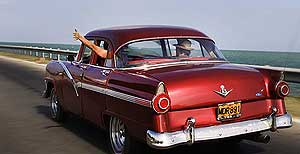 hoped that wholesale reconstruction manages to retain at least the facades of these impressive old buildings. hoped that wholesale reconstruction manages to retain at least the facades of these impressive old buildings.
Choosing to stay at the old and, it has to be said, slightly shabby Sevilla Hotel in the heart of the Old Town, rather than at the bland, modern Parque Central, a few blocks up on the main plaza, or the Nacional, out along the coastline, we were able to embrace the Havanan ambience pretty quickly.
This delightful old place, with a graceful central courtyard for cocktails, encapsulates the essence of Havana. Once one of the capital’s favourite hotspots for international high society and low mobsters, it retains its original features that date back to the early 1900s. It has style, and history. Al Capone stayed here, as did Grahame Green, Josephine Baker and Caruso and a host of others.
Inside the courtyard, a succession of Cuban combos provide the sultry mix of salsa, rumba, jazz and tango that permeates the Cuban airwaves. The head waiter would surely be a winner on 'Come Dancing' and was eager to whisk any young 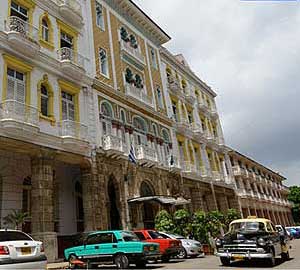 lady up for a dance. lady up for a dance.
Outside the hotel, a phalanx of engaging touts waits to take advantage of any unsuspecting tourist in the nicest possible way, and a long line of American limos is parked to tempt them into tours of the city. Private enterprise manages to raise its head here.
Agree a price before hand and go. Don’t expect that price to be necessarilythe one you pay at the end but never mind, it will be worth it. Out along the Malecon, the sea front promenade, to the Nacional Hotel, a huge grim edifice that testifies to its star- studded past with pictures of all the famous that have stayed here; up through suburbs of neat, imposing villas, showing evidence of some moneyed residents; up to the fort and castle on the headland, built in 16th century by the Spanish; back to another hilltop to see the impressive house where Che Guevera lived – and I thought he just roughed it in the jungle!
Our guide had commandeered his neighbour’s vintage Cadillac, complete with neighbour wedged behind the steering wheel, quite the largest man around and evidence that even in poor Cuba, obesity flourishes. He was accompanied by his daugher/niece/wife?, who just came for the ride.
We were shown Havana’s China Town – “but there’s no Chinese”, said our guide with a chuckle. He also told us that most people are employed, paid an average of around 20 US dollars a month, including 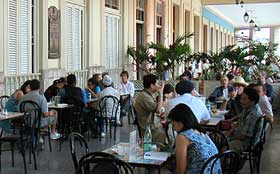 doctors, that all children receive a good state education until 16, that some small private businesses have been allowed to start, and that he thought things would change a lot in two or three years time, “when Raoul is in charge”. The font of knowledge is always a taxi driver, in this case the back seat driver. doctors, that all children receive a good state education until 16, that some small private businesses have been allowed to start, and that he thought things would change a lot in two or three years time, “when Raoul is in charge”. The font of knowledge is always a taxi driver, in this case the back seat driver.
Beware the helpful charmers on the streets, who offer to show you a ‘really authentic restaurant, not one of those tourist traps’. We fell for one and ended up in someone’s front parlour, with an assortment of other glum tourists who had been corralled by the owner’s network of agents, and had the one truly dreadful meal of our stay.
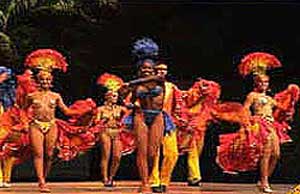 At the hotel and such tourist traps as the famous Floridita, the food was excellent and reasonably priced. The elegant pavement cafés fronting the big old hotels on Central Parque charge around £2 to £3 for a generous cocktail, with groups of musicians, of varying proficiency, moving from venue to venue, eager to sell you their CD. Tip: sit at the back away from the front where a variety of street vendors can get at you. At the hotel and such tourist traps as the famous Floridita, the food was excellent and reasonably priced. The elegant pavement cafés fronting the big old hotels on Central Parque charge around £2 to £3 for a generous cocktail, with groups of musicians, of varying proficiency, moving from venue to venue, eager to sell you their CD. Tip: sit at the back away from the front where a variety of street vendors can get at you.
Saying a fond farewell to Havana, we moved not into the sunset but through the sort of tropical downpour that confirms we do still have gentle rain in England. That explains the lushness of the Cuban countryside, much of it uncultivated, with a few animals grazing here and there.
Varadero is Cuba’s premier tourist venue, its prime beaches now attracting over a million visitors a year, mainly Europeans and Canadians. The US still bans its citizens from travelling to Cuba, though increasing numbers are doing so, many via Canada.
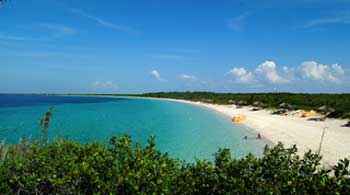 Inevitably, major development of hotel resorts is gobbling up land along the shoreline here, some investment from Canada, much from China – they get everywhere. And some of these buildings are truly forbidding, looking more like fortresses than hotels, Inevitably, major development of hotel resorts is gobbling up land along the shoreline here, some investment from Canada, much from China – they get everywhere. And some of these buildings are truly forbidding, looking more like fortresses than hotels,
Fortunately, our stay was in the exclusive section of a rather less fearsome resort, the Blau Marina, its ‘bungalows’ dotted throughout the grounds in a style that combined palladian overtones with South Fork pretensions. The food was very good indeed, though at the rate that lobsters are being consumed here and elsewhere in the region, they may well become the next species under threat of local extinction.
The beaches are largely left untended, vestiges of the pre-Castro era remaining in derelict beach bars and dilapidated palm parasols. With crystal clear seas, gentle lapping waves and safe bathing, these are the great and as yet unspoilt charms of the area.
The actual town of Varadero has attracted the jet set since long before the jet, starting as something of a Cuban Frinton, a resort for the Cuban elite in the 1800s, before attracting Americans in the 1920s – that man Capone again making an appearance. He is only outdone in Havana by that other famous American visitor, Hemingway, with tourists seeking out the numerous bars claiming his patronage.
Now, Veradero seems a 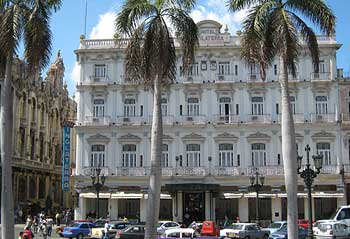 touch jaded with tourists, delighting in giving directions in completely the wrong direction (as also do the Venetians, by the way). A gaggle of markets here provide some evidence of indigenous craftsmanship but not much. touch jaded with tourists, delighting in giving directions in completely the wrong direction (as also do the Venetians, by the way). A gaggle of markets here provide some evidence of indigenous craftsmanship but not much.
Indeed, there is little for the visitor to buy in Cuba – or for Cubans either for that matter. With America’s trade embargo still largely in place, and little finance for imports anyway, basic commodities are limited and luxury ones pretty non-existent. The one exception, of course, is the Cuban cigar. The other major indulgence is rum, sloshed liberally into all manner of wonderful cocktails.
These, plus the sunshine, the wide smiles, the sparkling sea and the ever-present music give Cuba its special appeal. “This is Paradise,” one elderly Quebecan was heard to say, and coming from the snow-covered North it would understandably seem so. Coming from freezing Britain, it seemed a bit like that to us too.
From the top, cocktails of every size and hue; street musicians in Havana; one of the vintage American cars, many of which have engines from Ladas; the gracious Sevilla Hotel; the pavement cafe at the Inglaterra Hotel; spectacular shows for tourists at the Tropicana and the Nacional; Varadero's pristine beaches; Inglaterra's example of Havana's colonial style. Travel arranged through Cuba Direct.
|